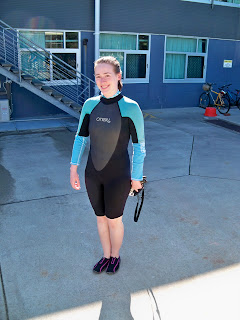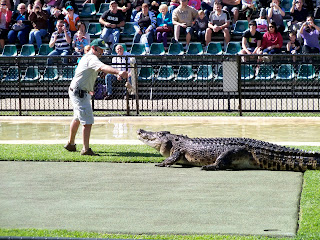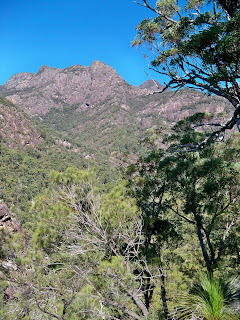I spent four days this past week in a beautiful rainforest. Technically, this is the rainforest that "Fern Gully" was based on, but since I haven't actually seen the movie, I can't verify how accurate the comparison is. We were staying in Binna Burra, which is a few minutes' hike outside of Lamington National Park (you can't stay in the park for conservation reasons), in a rustic bunkhouse. Out in front of the buildings was a nice sloping lawn, where we could spot pademelons grazing at dusk. I had never heard of a pademelon before this trip, but I saw a LOT of them. They are marsupials, and look rather like small wallabies - very cute, though skittish. We also saw a bandicoot, which looked more-or-less like a large rat, but is also a marsupial.
A large portion of the week was spent hiking and doing fieldwork. I think I totaled about 45 km over the course of the 4 days, even though I didn't go on the 12 km waterfall hike on the last day due to rain, leeches, and being tired. We hiked through areas of wet sclerophyll, dry sclerophyll, sub-tropical rainforest, warm temperate rainforest, cool temperate rainforest, and heathland - I bet you didn't know that vegetation in a relatively small area could have so many different classifications! One morning, my group got up at 4:30 a.m., hiked to the top of a cliff, watched the sunrise, and counted the calls of specific species of birds. It was cold, but worth it.
Sunrise from the cliff top - beautiful!
The trip included many educational opportunities, and I have now learned that:
1. Strangler fig ecology is pretty neat. They have a weird symbiosis (mutualism) with a specific species of wasp. If you are in need of some more procrastination after reading this blog post, you should go look it up.
2. Bower birds make interesting nests. The male builds a mating platform (those upright twigs in the picture below), and then attempts to lure the female in with a carefully arranged selection of bright blue objects. He also dances for her. The male with the best platform, blue objects, and dancing abilities wins.
3. Many things in the rainforest try their best to painfully stab you with nasty thorns or spikes. These include caterpillars, plants like the stinging tree, and the ever-present wait-a-while vine (a wall of which is pictured). Even a slight touch can cause a large amount of pain.
4. Scrub turkeys will gladly eat leeches, if fed them. This is useful to know when you are very tired of being bitten by the leeches.
5. Allowing college students to use play dough during lecture is great for keeping people awake, and is a good teaching tool for kinesthetic learners. However, there is a good chance that the models of plants and volcanos that you were hoping for will instead devolve into collaborative creation of penguins and ichthyosaurs eating fish.
6. Even when you see the venomous creatures that Australia is famous for, they probably aren't interested in hurting you. We saw a Red-bellied Black Snake (creatively named, of course, for its black back and red belly), which is on those lists of Scary Venomous Snakes, but really only bites if provoked. It was just on the path in front of us, hanging out in a patch of sun, and let us get a few pictures before gliding off into the vegetation.
Overall, we spent a lot of time looking at waterfalls, buttress roots, epiphytes (ferns, palms, mosses, etc. that grow in trees), spider holes, and glow worm threads, among other things.
[Side note: I hope to never have to hear the glow worm poem again on this trip, but I doubt I will be so lucky. It is from a card that was found at a rest stop on a previous field trip, and has been recited numerous times in my group. It goes:
"I wish I were a glow worm
A glow worm's never glum
'Cause how can you be grumpy
When the sun shines out your bum?"]
Three tall waterfalls, viewed from an observation platform over a cliff edge
On the final night of the Lamington trip, our group participated in a bush dance, led by one of the staff at the Binna Burra resort (which is across the road from the bunkhouses we were lodged in, and is where we ate all our meals). This involved simple group dances, such as the heel-and-toe and strip the willow, and one where you had to hop around like kangaroos. There was a fair amount of crashing into one another and not dancing in time with the music, but it was still fun! I did miss being able to co-teach lindy hop at UQ for a second week, but had an enjoyable time anyway.




















































